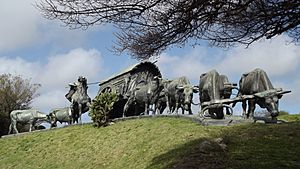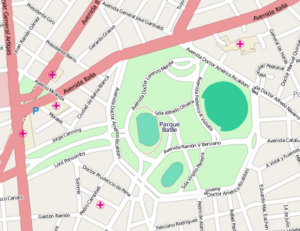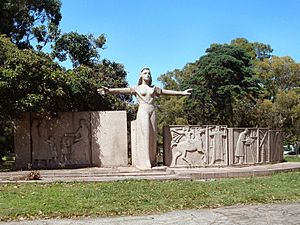Parque Batlle facts for kids
Quick facts for kids
Parque Batlle–Villa Dolores
|
|
|---|---|
|
Barrio and park
|
|

Monumento La Carreta
|
|

Street map of Parque Batlle–Villa Dolores
|
|

Map of Montevideo highlighting the barrio
|
|
| Country | |
| Department | Montevideo Department |
| City | Montevideo |
| Website | www.parquebatlle.tk |
Parque Batlle is a famous barrio (which means neighborhood or district) and a huge public park in Montevideo, Uruguay. It used to be called Parque de los Aliados (Allied Park). The park is named after José Batlle y Ordóñez, who was a very important President of Uruguay in the early 1900s.
Contents
Where is Parque Batlle?
This neighborhood is located in Montevideo, between Avenida Italia and Rivera Avenue. It includes smaller areas like Belgrano, Italiano, and Villa Dolores. It shares borders with other neighborhoods such as Tres Cruces, La Blanqueada, Unión, Buceo, and Pocitos.
The park itself is really big, covering about 60 hectares (that's like 150 acres!). People call it the "lung" of Montevideo because it has so many different kinds of trees. It's also home to the Estadio Centenario, which is Uruguay's national football (soccer) stadium. You can also find the famous "La Carreta" monument here.
A Look at the Park's History
The idea for Parque Batlle started in 1907. A man named Pablo Nereo Gabriel Antonio Pereira donated a large piece of his land for a park. This land was known as "Campo Pereira."
- Park Design and Planting: In 1911, a French landscape architect named Carlos Thays began planting trees and adding beautiful features to the park.
- First Name Change: In 1918, after the Allied armies won World War I, the park was named "Allied Park." This honored the heroes of the Allied Forces.
- Expansion and Second Name Change: The park grew even larger thanks to more land donated by Antonio Pereira. On May 5, 1930, it was renamed "Parque Batlle y Ordóñez." This was to remember President José Batlle y Ordóñez, who had passed away in 1929.
- New Sports Facilities: In the same year, the Estadio Centenario football stadium opened. Later, between 1935 and 1938, an athletics track and a velodrome (a track for bicycle racing) were built.
- National Historic Monument: Because of its importance, Parque Batlle was officially named a National Historic Monument Park in 1975.
The Parque Batlle Neighborhood
Parque Batlle is one of seven neighborhoods along the coast of Montevideo. It's known for having many people living there. Most families in this area have medium-high or high incomes.
What to See in the Park
Parque Batlle is one of the three biggest parks in Montevideo, along with Parque Prado and Parque Rodó. It's a great place for sports and outdoor activities.
- Estadio Centenario: This stadium can hold 70,000 people! It was built for the very first FIFA World Cup in 1930. It's not just a national football stadium; it also has a football museum inside.
- Other Sports Facilities: The park also has the Municipal Velodrome for cycling. There are two smaller stadiums, Parque Palermo and Parque Luis Méndez Piana, and a place for target shooting.
- Outdoor Activities: It's a perfect spot for walking, hiking, exercising, and enjoying the fresh air from all the trees.
Villa Dolores and the Zoo
Villa Dolores is a part of the Parque Batlle neighborhood. It got its name from the original home of Don Alejo Rossell y Rius and Doña Dolores Pereira de Rossel. They started a private collection of animals there, which later became a public zoological garden (zoo).
In 1919, the animal collection was given to the city. Later, in 1955, the Planetarium of Montevideo was built within the zoo's grounds.
Famous Monuments
Parque Batlle is home to several important statues and monuments.
- La Carreta: This impressive bronze monument was created by José Belloni in 1934. It shows strong yoked oxen pulling a loaded wagon. You can find it near the Estadio Centenario. It became a national monument in 1976.
- Discobolus: Another statue in the park is a bronze copy of the famous ancient Greek sculpture, the Discobolus of Myron.

- Obelisk of Montevideo: On the west side of Parque Batlle, near Artigas Boulevard, stands the Obelisk of Montevideo. This monument was built in 1938 to honor the people who created Uruguay's first Constitution. It's a tall, three-sided granite obelisk, about 40 meters (130 feet) high. It has three bronze statues representing "Law," "Liberty," and "Force." There's also a cool hexagonal fountain around its base. It's been a National Heritage Site since 1976.
Important Buildings Nearby
Besides the stadium, the area around Parque Batlle has many buildings known for their interesting architecture.
- Hospitals: Several hospitals are located here. The biggest is the Hospital de Clínicas, which is part of the University's Faculty of Medicine. Other important hospitals include the Italian Hospital, Hospital Pereira Rossell, and the Hospital Británico. The Hospital Británico has been a National Heritage Site since 1975.
- Other Sites: Two other buildings, both across from the Estadio Centenario, are also National Heritage Sites: the Conedor Universitario No. 2 (the University Canteen) and the Instituto de Higiene (Hygiene Institute).
Places to Worship
- Parish Church of St Ignatius of Loyola, located at Alejo Rossell y Rius 1613. This is a Roman Catholic church run by the Jesuites.
See also
 In Spanish: Parque Batlle para niños
In Spanish: Parque Batlle para niños




